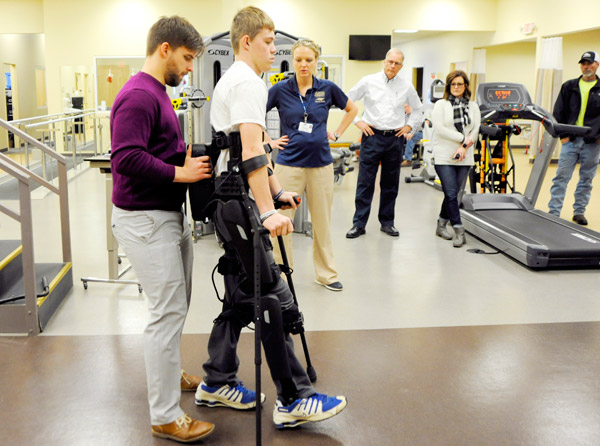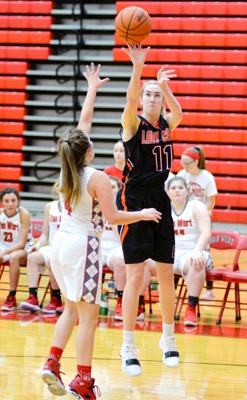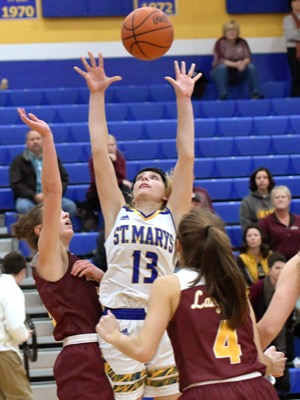Wednesday, November 28th, 2018
Mission: Learning to walk again
Robotics program helps teen injured during football game
By Sydney Albert

Photo by Dan Melograna/The Daily Standard
Zachary Waugh of ReWalk Robotics helps support Shane Homan as he takes his first steps using an exoskeleton Tuesday at the Community Sports and Therapy Center in Celina. The teen's parents, Jeff, far right, and Tara Homan, observe in the background.
CELINA - With a whirr from the ReWalk exoskeleton, support from the Community Sports and Therapy Center staff and a pair of crutches, 17-year-old Shane Homan stood up.
Zachary Waugh, a business development manager with ReWalk Robotics, helped CSTC staff adjust the exoskeleton, checking the length of the crutches, the straps and body corset, the alignment of Homan's knees against the suit's cushions, even discussing his shoe size. All of those factors and more have to come together to ensure Homan is able to safely and comfortably walk again.
Many local residents have probably heard of Homan's story or seen the #Shane-Strong signs outside of businesses and homes. The Coldwater junior fractured his fifth thoracic vertebra, located between the shoulder blades, after taking a hard hit at a junior varsity football game between the Coldwater Cavaliers and St. Marys Roughriders earlier this year. Those in the Coldwater community and beyond have rallied to show their support, with many people and businesses donating time, money or resources to the Homan family.
Tara Homan, the teen's mother, looked on, joking with some of the staff as they helped get her son up and moving. She said while her son had practiced in something resembling the exoskeleton at Miami Valley Hospital, he hadn't had the ability to walk longer distances.
Leaning from one side to the other, Shane Homan took turns unloading the weight from each of his legs, a movement he needs to master to walk in the suit. He practiced different movements - pivoting left and right, leaning forward and back, testing his reflexes with the crutches and being coached on maintaining his balance.
After plenty of practice and some minor adjustments, a staff member strapped on a watch, which controls the suit. A beeping sound filled the room and the exoskeleton whirred to life once more as Homan took a step forward.
It took some practice, for both Homan and the staff helping him, to get a feel for things. Waugh stepped in at times to make more adjustments and demonstrate how to help Homan get used to the movements of shifting his hips, giving tips on balance and Homan's timing with the crutches. Soon, the teen was taking more consecutive steps, walking out of the CSTC and into a hallway beyond.
Homan isn't the only area resident using an exoskeleton. He was joined on Monday by Caleb Kunkle, 19, who was injured in a car accident two years ago, and Todd Reigelsperger, 27.
Almost a decade ago, Reigelsperger was a Coldwater High School senior when he suffered a spinal injury in a car accident. Now, Reigelsperger has been using the suit for two and a half years. As Homan was being trained on the exoskeleton, Reigelsperger looked on, offering moral support.
Reigelsperger said he uses the suit as other people would use treadmills or other workout equipment. Doing so makes him feel healthier. He listed some benefits of using the suit, including decreased back pain and increased blood circulation. When asked how it felt to use the suit, he said it was hard to describe. It could feel like walking on air, because you know your legs are moving but you can't feel them, he said.
Yet despite the benefits of the suit, not many have been built. CSTC Executive Director Robert Hibner said the suit Homan was wearing was one of only about 500 in the world.
V.J. Westerheide, a friend who helped do some of the initial research for Reigelsperger and the donor of CSTC's suit, said before CTSC got an exoskeleton, the closest place with access to such technology was in Cincinnati. The suits aren't cheap, costing about $100,000 each, and insurance companies don't cover them. Westerheide and several other attendees, however, hoped that might soon change.
As Homan walked in the exoskeleton, Hibner recorded the process on video - part of documenting the medical benefits of the suit and evidence for insurance companies, he said.
"All these things that we take for granted when we walk. We shift our leg to move this way, we shift this way to move this leg, and the foot comes up so that we don't catch our toes. That's why people who have a stiff knee have trouble walking, why someone who can't pull their toes up, that's why they catch their feet, because the foot doesn't come off the ground. This can adjust all that with that computer," Hibner said.



